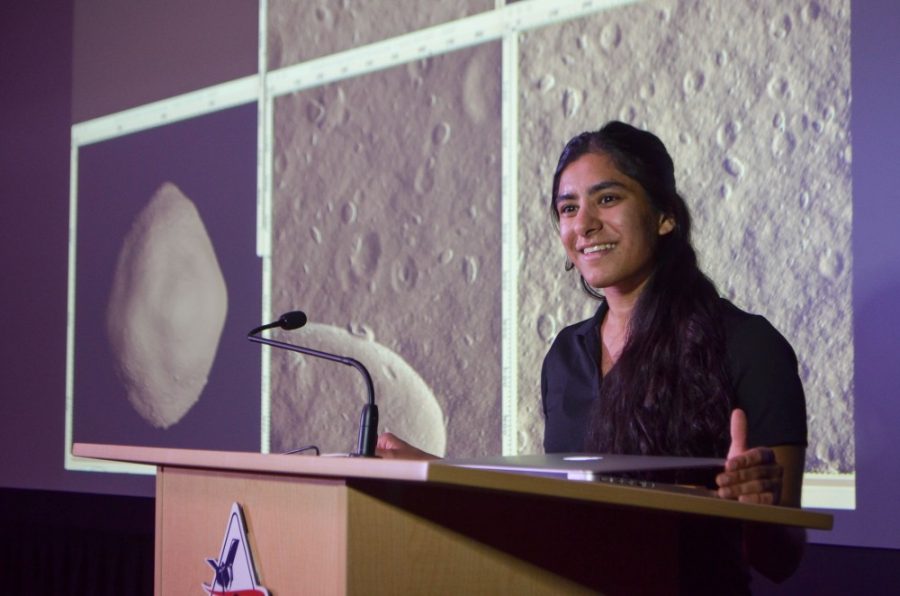To be named a 2018–19 Churchill Scholar is no easy feat, but University of Arizona senior Namrah Habib, a double major in aerospace and chemical engineering, came out on top after a competitive, male-dominated applicant process.
Not only was Habib the only UA undergraduate represented among 16 national winners, but she also was one of four women to be named a scholar. The pool of applicants included 35 women and 66 men who are all pursuing bachelor’s degrees in mathematics, science and engineering, according to The Winston Churchill Foundation of the United States.
“I was happy I was selected,” Habib said. “My mentor encouraged me to apply.”
Her mentor is Daniella DellaGiustina, a lead scientist with OSIRIS-REx, a NASA-funded space mission largely operated from the UA Lunar and Planetary Laboratory. Habib has worked as an image processing intern at the lab since July 2014.
“She is very tenacious. She doesn’t give up. That is a great skill for a young woman in STEM to have: persistence,” DellaGiustina said.
Women make up half of the total U.S. college-educated workforce but only 29 percent of the science and engineering workforce, according to National Girls Collaborative Project. Nearly half of the team DellaGiustina runs is comprised of women, making them an “exception,” she said, to the current STEM landscape.
Habib won’t be seeking full-time employment after graduating in May. Her Churchill scholarship will allow her to pursue a Master of Philosophy in Astronomy at the Institute of Astronomy at the University of Cambridge in England. The scholarship includes at least $50,000 for tuition, a $2,000 research grant and additional funding for travel and living costs.
“I would like to get my Ph.D. afterward and work on space missions. A lot of missions are run by companies and universities,” Habib said.
She said her time at the UA has already helped her gain experience for her future career.
RELATED: UA Law Student in the running to become the next CEO of Casino Del Sol
At the Lunar and Planetary Laboratory, lead and student researchers are tracking the progress of OSIRIS-REx, a spacecraft launched in September 2016 to collect samples from the asteroid Bennu. Habib helps DellaGiustina with a camera system documenting the spacecraft’s journey.
“She worked implementing software and standard operating procedures so that when we bring in images from the OSIRIS-REx camera suite into our labs, we can view those in stereo, something like 3D,” DellaGiustina said.
Habib began her internship meticulously counting rocks and pictures. Impressed with her work ethic, DellaGiustina invited Habib to do more “interesting projects” for the lab. That is how Habib started working with the mission’s principal investigator, Dante Lauretta.
“She is brilliant. She has made an enormous impact on our mission,” Lauretta said. “She can go into software codes scientists are writing or using, and she can clean them up. She can write up a document to describe what it does and how it does it and really help future users understand what they have in front of them.”
He added, “Keep an eye on her. She will be a superstar in the future.”
RELATED: Graduate (and undergrad) students prepare to ‘Showcase’ research
The future Habib is heading toward wouldn’t be possible, she said, without her time at the UA.
Not only does she regularly receive guidance from mentors at Lunar and Planetary Laboratory, she said, but the university has helped her improve personally and professionally.
“The UA has taught me what’s good and not good to do. It also taught me to try anything,” she said. “It changed my perspective on what I want to do and what is really engineering.”
After what she called an “intimidating” freshman year, Habib has gone far.
Habib contributed to almost everything the imaging processing team does, according to DellaGiustina, and has co-authored a peer-reviewed research paper with DellaGiustina about a meteorite, the Fukang pallasite, for the scientific journal Meteoritics & Planetary Science.
Additionally, Habib has won several other accolades, including being named one of Aviation Week Network’s Top 20 Technology Leaders of Tomorrow.
Follow Kristan Obeng on Twitter









